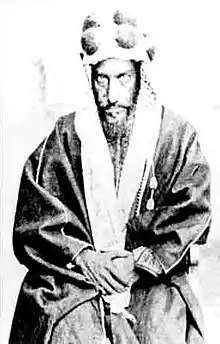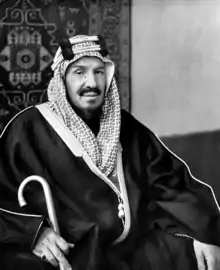Noura bint Abdul Rahman Al Saud
Noura bint Abdul Rahman Al Saud (Arabic: نورة بنت عبد الرحمن بن فيصل آل سعود) (1875 – July 1950) was a member of the House of Saud and the elder sister of King Abdulaziz. Madawi Al Rasheed argues that she is the first example of royal women in Saudi Arabia who are introduced to support the view of the progressive royalty.[1]
| Noura bint Abdul Rahman Al Saud | |||||
|---|---|---|---|---|---|
| Born | 1875 Riyadh, Emirate of Nejd | ||||
| Died | July 1950 (aged 74–75) Riyadh, Saudi Arabia | ||||
| Burial | |||||
| Spouse | Saud Al Kabir bin Abdulaziz Al Saud | ||||
| Issue | Mohammed Hessa Al Jawhara | ||||
| |||||
| House | House of Saud | ||||
| Father | Abdul Rahman bin Faisal Al Saud | ||||
| Mother | Sara bint Ahmed Al Sudairi | ||||
Early life


Noura was born in Riyadh in 1875.[2][3][4] She was the eldest daughter of Abdul Rahman bin Faisal and elder sister of Abdulaziz bin Abdul Rahman, who would become the founder of modern Saudi Arabia.[2][5] Noura's full siblings included Faisal, Abdulaziz, Bazza, Haya and Saad.[6]
Her mother was a member of the Sudairi family,[7] Sara bint Ahmed bin Muhammad Al Sudairi.[8][9] She died in 1908[10] or in 1910.[9][11] Noura's maternal grandmother was Hessa bint Muhanna bin Saleh Al Nuwairan.[6]
Noura learned to read and write from her early years which was a very rare quality for an Arab girl at that period of time in the country.[2][12]
Relations and activities
King Abdulaziz and Noura were very close to each other.[5][13] It is well known that on several occasions, King Abdulaziz identified himself in public by proclaiming “I am the brother of Noura.”[11] Mohammad bin Abdul Rahman, another of her younger brothers, also used to say the same.[14]
Noura was reported to have the “minds of 40 men” and great wisdom.[5] She encouraged her brother to regain the leadership of the country when the family was in exile in Kuwait.[3] Additionally, she was one of the few women of her period who learned to read and write.[14] Her charismatic personality and strong political ideas led to King Abdulaziz's paying attention to her opinion about many crucial issues.[5] Eventually, she became one of his main advisors[15] and even took his place in running the state when he was unable to do so. She was also known to be quite progressive and outspoken. For instance, when the telephone was first introduced to the country, many Islamic clerics rejected it and considered it to be a tool of the devil, but she actively supported its use and argued that it was an amazing device that they would not be able to live without.[3] She also played an important role in teaching her nephews and nieces the system of social norms. It is reported that whenever one of them misbehaved as a child, the King would send him to their aunt for discipline.[16] In addition, Noura was a pioneer in charity activities and the founder of the first charity program for the poor and orphans in the country.[4]
Dame Violet Dickson, a Briton, met Noura in 1937 and stated that she was the most charismatic and important personality in the Arabian Peninsula at that period.[4] Princess Alice, a British royal, who visited Saudi Arabia in 1938, also met Noura and described her as follows: "Noura, is about sixty and said to be his [King Abdulaziz's] chief adviser, a fine, handsome woman."[17]
Personal life

Noura bint Abdul Rahman married Saud bin Abdulaziz bin Saud bin Faisal in 1905.[5][12] Her husband was from the Al Kabir branch of the House of Saud, consisting of descendants of Saud bin Faisal, elder brother of Noura's father, Abdul Rahman Al Saud.[18] Saud bin Faisal ruled in Arabia from 1871 to 1875.[19]
In 1903, the Al Kabir branch began to question King Abdulaziz's right to rule. And they took refuge from their mothers' tribe, Ajman.[3] Later the King pardoned Saud Al Kabir, the most powerful surviving Al Kabir family member.[20] Saud Al Kabir was then married to Noura.[19][21][22] In other words, Saud Al Kabir's loyalty to Abdulaziz was secured as a result of his marriage to Noura bint Abdul Rahman.[23] Since then, the members of Al Kabir branch have become influential, but they have been mostly kept away from political power.[22] On the other hand, Saud Al Kabir served as the governor of the Qassim province following the foundation of Saudi Arabia in 1932.[24]
Noura gave birth to Mohammed, Hassa, and Al Jawhara. Her son, Mohammed bin Saud Al Kabir, was a senior and respected prince due to his powerful tribal knowledge and connections.[25] Her daughter, Al Jawhara, was the third spouse of King Faisal,[5][26] and they had a daughter, Mashael bint Faisal.[12][27] Noura's grandson, Sultan bin Mohammad bin Saud Al Kabir, is a businessman and was the 12th billionaire in the Arab world in 2013.[28]
Noura's family lived in Sharia Palace in Alkharag city.[9] Following the establishment of the Kingdom the family moved to the newly built palace, Al Shamsiah Palace, outside Riyadh[29] which is in the Al Murabba neighborhood.[12]
Death
Noura died in July 1950 at the age of 75, a few years before King Abdulaziz.[11][12] She was buried in Al Oud cemetery in Riyadh.[2] King Abdulaziz was buried in the same cemetery next to her in 1953.[30]
Legacy
Princess Noura University was named in 2008 by King Abdullah in her memory.[3][31] The university is considered to be one of the largest universities of its type and can accommodate 50,000 female students. The university reflected King Abdullah’s appreciation for the oldest daughter of Imam Abdul Rahman bin Faisal Al Saud, father of King Abdulaziz.[5]
References
- Madawi al Rasheed (11 June 2018). "Vogue princess is hijacking Saudi women activists' struggle". Middle East Eye. Retrieved 18 October 2020.
- "الأميرة نورة بنت عبدالرحمن و أسرار في تأسيس دولة السعودية". Echo Arabi (in Arabic). 2 November 2019. Retrieved 7 September 2020.
- Madawi Al Rasheed (30 April 2013). A Most Masculine State: Gender, Politics and Religion in Saudi Arabia. Cambridge University Press. p. 43. ISBN 978-0-521-76104-8.
- Abdulateef Al Mulhim (21 September 2012). "Saudi women and their remarkable achievements". Arab News. Retrieved 29 July 2013.
- Falih Al Dhibyani (16 May 2011). "Noura, a trusted sister of Kingdom's founder". Saudi Gazette. Archived from the original on 2 April 2015. Retrieved 29 April 2012.
- "نورة بنت عبد الرحمن.. السيدة السعودية الأولى". Al Bayan (in Arabic). 24 May 2020. Retrieved 7 September 2020.
- Mordechai Abir (April 1987). "The Consolidation of the Ruling Class and the New Elites in Saudi Arabia". Middle Eastern Studies. 23 (2): 150–171. doi:10.1080/00263208708700697. JSTOR 4283169.
- Fahd Al Semmari (Summer 2001). "The King Abdulaziz Foundation for Research and Archives". Middle East Studies Association Bulletin. 35 (1): 45–46. doi:10.1017/S0026318400041432. JSTOR 23063369.
- "Noura bint Abdul Rahman.. Adviser to the King and the Secrets Portfolio". Saudi 24 News. 17 May 2020. Retrieved 22 September 2020.
- Nadav Samin (2015). "4. Marriage and Lineal Authentication". Of Sand or Soil: Genealogy and Tribal Belonging in Saudi Arabia. Princeton University Press. p. 118.
- "King Abdulaziz' Noble Character" (PDF). Islam House. Retrieved 29 April 2012.
- "نورة بنت عبدالرحمن.. السيدة الأولى". Al Ayam (in Arabic). 24 May 2020. Retrieved 15 July 2020.
- Helen Chapin Metz (1992). "Saudi Arabia: A Country Study". Retrieved 9 May 2012.
- Prince Mohammed bin Abdul Rahman Al Faisal Al Saud (PDF). Prince Mohammed bin Abdul Rahman and Family Charitable Organization. p. 55. Archived from the original (PDF) on 17 September 2012.
- Mark C. Thompson (2015). "Saudi Women Leaders: Challenges and Opportunities". Journal Journal of Arabian Studies. 5 (1): 15–36. doi:10.1080/21534764.2015.1050880. S2CID 154226553.
- Stig Stenslie (2011). "Power Behind the Veil: Princesses of House of Saud". Journal of Arabian Studies: Arabia, the Gulf, and the Red Sea. 1 (1): 69–79. doi:10.1080/21534764.2011.576050. S2CID 153320942.
- "The journey of a lifetime". Geographical. July 2011. Archived from the original on 21 May 2014. Retrieved 21 July 2013.
- Joseph A. Kechichian (2001). Succession in Saudi Arabia. New York: Palgrave. ISBN 9780312238803.
- William B. Quandt (1981). Saudi Arabia in the 1980s: Foreign Policy, Security, and Oil. Washington DC: The Brookings Institution. p. 79. ISBN 0815720513.
- Simon Henderson (1994). "After King Fahd" (Policy Paper). Washington Institute. Retrieved 2 February 2013.
- Richard Ben Cramer (15 May 1983). "What Hath Allah Wrought?". Philadelphia Inquirer. Philadelphia. ProQuest 1814359370. Retrieved 5 September 2020.
- Simon Henderson (12 October 2009). "Factors Affecting Saudi Succession are a Family Affair". The Cutting Edge. Retrieved 9 May 2012.
- Sabri Sharif (2001). The House of Saud in Commerce: A Study of Royal Entrepreneurship in Saudi Arabia. New Delhi: I. S. Publications. ISBN 81-901254-0-0.
- Mohammad Zaid Al Kahtani (December 2004). "The Foreign Policy of King Abdulaziz" (PDF). University of Leeds. Archived from the original (PDF) on 12 October 2017. Retrieved 21 July 2013.
- Louisa Dris-Aït-Hamadouche; Yahia H. Zoubir (Spring 2007). "The US-Saudi Relationship and the Iraq War: The Dialectics of a Dependent Alliance". Journal of Third World Studies. 24 (2): 124. ProQuest 233188283.
- "Saudi Arabia" (Country Readers Series). Association for Diplomatic Studies and Training. p. 57. Retrieved 7 January 2021.
- "Family Tree of Faisal bin Abdulaziz bin Abdul Rahman Al Saud". Datarabia. Retrieved 29 April 2012.
- "Prince Sultan Al Kabeer". Forbes Middle East. Archived from the original on 21 September 2013. Retrieved 20 September 2013.
- "Murabba Palace: The historical divan of King Abdul Aziz". McClatchy - Tribune Business News. Jeddah. 24 September 2012. ProQuest 1065122513. Retrieved 5 July 2020.
- Jennifer Bond Reed (2006). The Saudi Royal Family (Modern World Leaders). Chelsea House Publishers. p. 43.
- Mohamed Al Ghamdi (30 October 2008). "Light dawns on girls' education". Saudi Gazette. Archived from the original on 26 May 2013. Retrieved 14 August 2013.